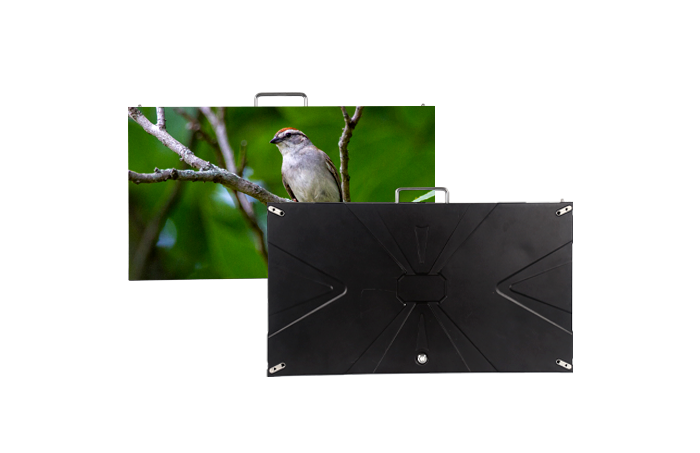source:Industry Trends release time:2022-10-13 Hits: Popular:led screen wholesaler

In the PN junction of some semiconductor materials, when the injected minority carrier recombines with the majority carrier, the excess energy is released in the form of light, thus the electric energy is directly converted into light energy. PN junction with reverse voltage, minority carrier injection is difficult, so it does not emit light. The diodes, which use the principle of injection electroluminescence, are called light-emitting diodes, commonly known as leds.
The luminous color and luminous efficiency of LED are related to the materials and processes used to make LED. At present, red, green and blue are widely used. Due to the LED working voltage low (only 1.5-3V), can actively light and have a certain brightness, brightness can be voltage (or current) regulation, itself and impact resistance, vibration resistance, long life (100,000 hours), so in large display equipment, there is no other display mode and LED display mode.
LED electronic display is made of compound materials pn junction photoelectric devices. It has the electrical characteristics of pn junction device: I-V characteristics, C-V characteristics and optical characteristics: spectral response characteristics, luminescence intensity pointing characteristics, time characteristics and thermal characteristics.
1, LED electrical characteristics
1.1 I-V characteristics To characterize the main parameters of pn junction preparation performance of LED chip. The I-V characteristics of LED have nonlinear and rectifying properties: unidirectional conductivity, that is, applied positive bias shows low contact resistance, and vice versa, high contact resistance.
(1) Forward dead zone: (Figure oa or oa 'section) Point a is the opening voltage for V0. When V < Va, the applied electric field cannot overcome the barrier electric field formed by carrier diffusion, and R is large. The value of the opening voltage is different for different LED, GaAs is 1V, red GaAsP is 1.2V, GaP is 1.8V, GaN is 2.5V.
(2) Forward working area: the current IF is exponentially related to the applied voltage
IF IS qVF/KT - 1 (e) = -- -- -- -- -- -- -- -- -- -- -- -- -- -- -- -- -- -- -- -- -- -- -- -- -- IS to reverse saturation current.
When V > 0, the forward work area of V > VF IF rises with VF exponent IF = IS e qVF/KT
(3) Reverse dead zone: when V < 0, reverse bias is added to pn junction
When V= -VR and reverse leakage current IR (V= -5V), GaP is 0V and GaN is 10uA.
(4) Reverse breakdown region V < -VR, VR is called reverse breakdown voltage; VR voltage corresponds to IR, which is the reverse leakage current. When the reverse bias keeps increasing so that V < -VR, IR suddenly increases and breakdown occurs. Due to the different types of compound materials used, the reverse breakdown voltage VR of various leds is also different.
1.2 C - V characteristics
In view of the LED chip has 9×9mil (250×250um), 10×10mil, 11×11mil (280×280um), 12×12mil (300×300um), so the pn junction area is different, making its junction capacitance (zero bias) C≈n+pf.
The C-V characteristic is a quadratic function. It is measured by 1MHZ AC signal with C-V characteristic tester.
1.3 Maximum Power consumption PF mA
When the current flowing through the LED is IF and the tube voltage drop is UF, the power consumption is P=UF×IF
LED work, external bias, bias current must make the carrier composite light, and a part of the heat, so that the junction temperature rise. If the junction temperature is Tj and the external ambient temperature is Ta, then when Tj > Ta, the internal heat is transferred outward through the tube seat, and the heat (power) can be expressed as P = KT (TJ-TA).
1.4 Response time
Response time represents how quickly a display tracks changes in external information. Existing several display LCD (liquid crystal display) about 10-3~10-5S, CRT, PDP, LED are up to 10-6~10-7S (us).
① Response time from the perspective of use, is the delay time between LED lighting and off, namely tr and tf in the figure. The value of t0 in the figure is small and negligible.
② The response time mainly depends on the carrier lifetime, junction capacitance and circuit impedance of the device.
LED lighting time - rise time tr refers to the time that the power is switched on and the luminance reaches 10% of the normal value until the luminance reaches 90% of the normal value.
Read recommendations:
outdoor led screen modules manufacture
.P4 outdoor LED display.Cleaning of outdoor LED display screens